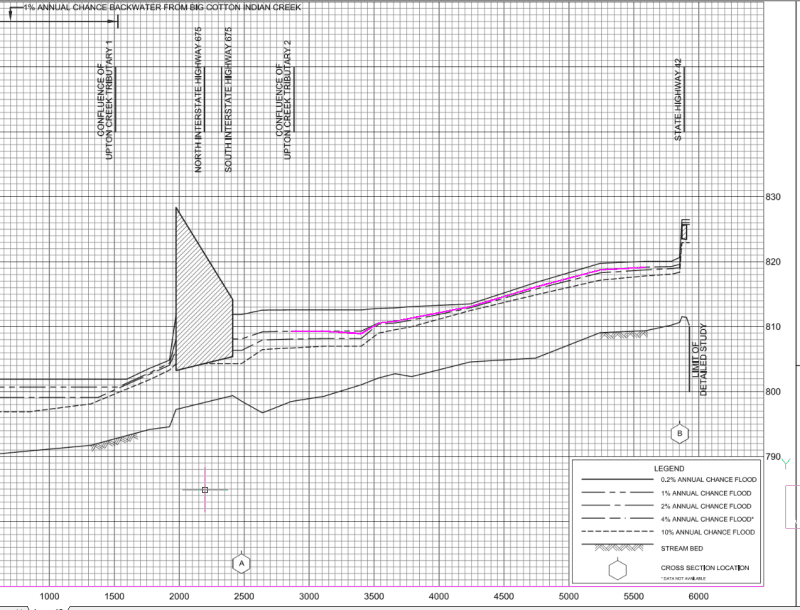Situation:
I'm doing a CLOMR based on an effective model given to me by the local county floodplain manager, who is an experienced PE contract guy from a big firm. He says it's the effective model. FEMA says they don't believe it's the effective model and want me to spend the months and/or years it will take to get the model directly from the FEMA clearinghouse. The floodplain manager says that's a curious request, and said to just run the duplicate effective model and plot its results against the flood profile in the creek, to confirm the model I have is good to do the analysis. He says as long as it's within a tenth it should meet FEMA spec for the CLOMR and we can waive away the comment from the FEMA reviewer.
When I run the model, it's a dead ringer all up and down the profile for the profile published in the FIS, it's an exact match except at one section. That one section is curious. It's got a 0.3 ft drop, and then rises back up. You can see the drop in this screenshot, where the pink line is the modeled profile traced over the FIS profile. The dip is at station 3400.

In digging through the data, it seems as if the profile bottoms out at critical depth at station 3400, then rises back up to a constant level that's dictated by the backwater at the interstate culvert. It seems as if this drop is due to choking effects, because that location in the plan has a narrow neck the water's moving through. It seems as if what happened was whichever engineer drew the profile saw the dip, didn't like the dip, and then just flattened out the profile elevation through that section instead of going with the results of the section.
But this puts me in a bind. If that's the case, and the engineer that drew the FIS flood profile fudged the profile at that section because of the dip, then me drawing the true profile over this fudged profile will not prove to FEMA that the model I'm using is the correct model to use. They're going to think I'm using the wrong model. So here's my long and tortured question:
Q: Is there some practice on the FEMA books that states when you have a dip due to a hydraulic jump or a choking effect, that you flatten out that dip when drawing the flood profile for the FIS?
If yes, then I'm golden. If no, then I'm in a lurch and am curious what sort of advice folks here might have.
Hydrology, Drainage Analysis, Flood Studies, and Complex Stormwater Litigation for Atlanta and the South East -
I'm doing a CLOMR based on an effective model given to me by the local county floodplain manager, who is an experienced PE contract guy from a big firm. He says it's the effective model. FEMA says they don't believe it's the effective model and want me to spend the months and/or years it will take to get the model directly from the FEMA clearinghouse. The floodplain manager says that's a curious request, and said to just run the duplicate effective model and plot its results against the flood profile in the creek, to confirm the model I have is good to do the analysis. He says as long as it's within a tenth it should meet FEMA spec for the CLOMR and we can waive away the comment from the FEMA reviewer.
When I run the model, it's a dead ringer all up and down the profile for the profile published in the FIS, it's an exact match except at one section. That one section is curious. It's got a 0.3 ft drop, and then rises back up. You can see the drop in this screenshot, where the pink line is the modeled profile traced over the FIS profile. The dip is at station 3400.

In digging through the data, it seems as if the profile bottoms out at critical depth at station 3400, then rises back up to a constant level that's dictated by the backwater at the interstate culvert. It seems as if this drop is due to choking effects, because that location in the plan has a narrow neck the water's moving through. It seems as if what happened was whichever engineer drew the profile saw the dip, didn't like the dip, and then just flattened out the profile elevation through that section instead of going with the results of the section.
But this puts me in a bind. If that's the case, and the engineer that drew the FIS flood profile fudged the profile at that section because of the dip, then me drawing the true profile over this fudged profile will not prove to FEMA that the model I'm using is the correct model to use. They're going to think I'm using the wrong model. So here's my long and tortured question:
Q: Is there some practice on the FEMA books that states when you have a dip due to a hydraulic jump or a choking effect, that you flatten out that dip when drawing the flood profile for the FIS?
If yes, then I'm golden. If no, then I'm in a lurch and am curious what sort of advice folks here might have.
Hydrology, Drainage Analysis, Flood Studies, and Complex Stormwater Litigation for Atlanta and the South East -
